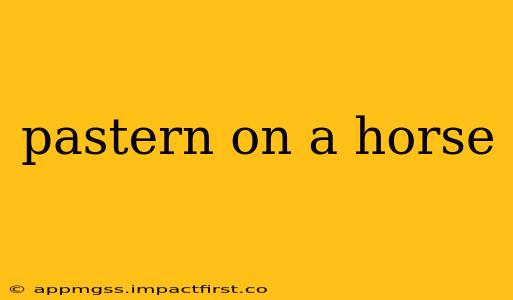The pastern, a crucial part of a horse's leg, often gets overlooked despite its significant role in locomotion, weight-bearing, and overall soundness. This comprehensive guide explores the anatomy, function, and common problems associated with the horse's pastern, providing valuable insights for horse owners, riders, and enthusiasts alike.
What is the Pastern on a Horse?
The pastern is the area of the horse's leg located between the fetlock joint and the hoof. It's essentially the short, sloping section of the leg that connects the fetlock to the coffin bone within the hoof. This relatively short segment is composed of two bones: the short pastern bone and the long pastern bone, which are connected by the pastern joint. The pastern joint is crucial for shock absorption and smooth movement, working in conjunction with the fetlock and coffin joints. The pastern's angle and conformation significantly impact the horse's gait, comfort, and overall performance.
What is the Function of the Pastern?
The primary function of the pastern is shock absorption. During locomotion, the pastern acts as a spring, absorbing the impact of each stride and minimizing the transmission of concussion to the horse's body. This shock-absorbing capacity is crucial for preventing injuries to the legs and joints, especially over long distances or during strenuous activity. Moreover, the pastern contributes to the horse's flexibility and maneuverability. Its angled structure enables the horse to navigate uneven terrain with ease and maintains balance.
What are Common Problems Affecting the Horse's Pastern?
Several issues can affect the horse's pastern, impacting its soundness and performance. Let's explore some of the most common problems:
Pastern Injuries:
Injuries to the pastern are relatively common, ranging from minor bruises and strains to more serious fractures and soft tissue damage. These injuries can result from impacts, overextension, or repetitive stress. Signs of pastern injury may include lameness, swelling, heat, and pain in the affected area.
Pastern Angle:
The angle of the pastern is a crucial aspect of conformation. An excessively upright pastern (too steep) can increase concussion and predispose the horse to injuries. Conversely, an excessively sloping pastern (too flat) may compromise the horse's stability and increase the risk of fetlock problems.
Navicular Syndrome:
While not directly related to the pastern bones themselves, navicular syndrome often impacts the pastern region. This condition involves inflammation or degeneration of the navicular bone, which lies within the hoof. The resulting pain often manifests as lameness and sensitivity in the pastern region.
Ringbone:
Ringbone is a degenerative joint disease affecting the pastern joint, specifically involving the growth of bony spurs. It can be debilitating and often results in chronic lameness and stiffness.
Sidebone:
Sidebone is ossification (bony hardening) of the lateral cartilages of the coffin bone, which sit on either side of the hoof at the top of the pastern region. It doesn't always cause lameness, but it can result in discomfort and stiffness.
How is Pastern Health Maintained?
Maintaining the health and soundness of the horse's pastern is essential for optimal performance and longevity. This includes regular hoof care, appropriate trimming and shoeing, proper conditioning, and avoiding overexertion. A balanced diet rich in essential nutrients is also crucial for supporting strong bones and healthy tissues. If you notice any signs of lameness or injury to your horse's pastern, it's crucial to seek professional veterinary attention promptly. Early diagnosis and intervention are key to effective treatment and preventing long-term complications.
What are the Different Types of Pastern?
There isn't a formal classification of "types" of pasterns, but instead, veterinarians and farriers assess the angle of the pastern. The ideal pastern angle is a balance between uprightness and slope. Too steep and the horse will experience more concussion, too slack, and they may lack support and stability. This angle is influenced by the overall conformation of the horse and its breed characteristics. It is important to note that ideal pastern angle is also influenced by the horse's discipline - a dressage horse may have a slightly different ideal pastern conformation compared to a racehorse.
How Can I Tell If My Horse Has a Pastern Problem?
Observe your horse carefully for any signs of lameness, such as reluctance to move, shorter strides, or limping. Check for swelling, heat, or any visible abnormalities in the pastern area. Any changes in gait or behavior should warrant a veterinary examination. Don't hesitate to consult your veterinarian if you have concerns about your horse's pastern health. Early detection and intervention can significantly impact the outcome.
This information is for educational purposes only and should not be considered a substitute for professional veterinary advice. Always consult with a qualified veterinarian for any concerns regarding your horse's health.
